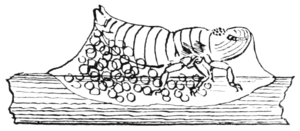this action accompanies a discharge of fluid or is an attempt at reaching for air I have not ascertained. Suddenly the insect begins to make bubbles by turning its tail out of the fluid, opening the posterior segment, which  Fig. 2.—The insect first emitting a clear fluid which fills up the interspaces between its body and the stem of grass upon which it rests.
Fig. 2.—The insect first emitting a clear fluid which fills up the interspaces between its body and the stem of grass upon which it rests.
 Fig. 3.—After the lapse of some time it begins rapidly to make bubbles.
Fig. 3.—After the lapse of some time it begins rapidly to make bubbles.
 Fig. 4.—Entire fluid filled with bubbles, and the froth thus made enveloping the stem.
Fig. 4.—Entire fluid filled with bubbles, and the froth thus made enveloping the stem.
Magnified Figures of Aphrophora, showing Successive Stages in the Production of Froth. appears like claspers, and grasping a moiety of air, then turning the tail down into the fluid and instantly allowing the inclosed air to escape (Fig. 3). These movements go on at the rate of seventy or eighty times a minute. At the outset the tail is moved alternately to the right and left in perfect rhythm, so that the bubbles are distributed on both sides of the body, and these are crowded toward the head till the entire fluid is filled with bubbles, and the froth thus made runs over the back and around the stem (Fig. 4).
Even when partially buried in these bubbles the tail is oscillated to the right and left, though when completely immersed the tail is only occasionally thrust out for air which is allowed to escape in the mass apparently without the right-and left movement, though of this I am not sure. It is interesting to observe that in half a minute some thirty or forty bubbles are made in this way—a bulk of air two or three times exceeding the bulk of the body—without the slightest diminution in the size of the body.
If the insect is allowed to become dry, by resting it upon a piece of blotting paper, and is then placed upon a piece of glass and a drop of clear saliva be allowed to fall upon it, it proceeds to fill up this fluid with bubbles in precisely the same manner as it did with its own watery secretion. It is quite difficult to divest the creature of the bubbles of air which adhere to the spaces between
